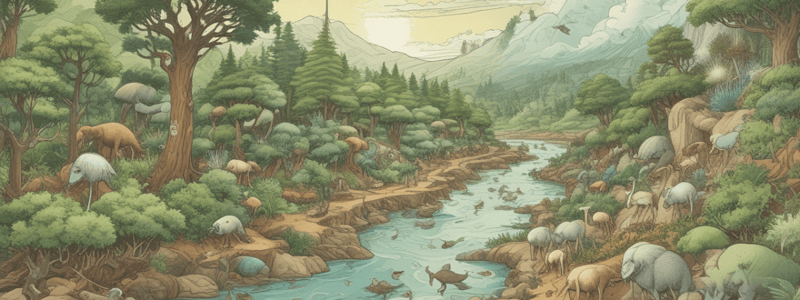Podcast
Questions and Answers
Who developed the Lotka-Volterra model?
Who developed the Lotka-Volterra model?
- Alfred J. Lotka in 1925 and Vito Volterra in 1926 independently (correct)
- Vito Volterra in 1925 and Alfred J. Lotka in 1926 independently
- A team of ecologists in the 1950s
- Alfred J. Lotka and Vito Volterra together
What is the initial application of the Lotka-Volterra model?
What is the initial application of the Lotka-Volterra model?
- Modeling population growth in ecology
- Modeling predator-prey interactions in ecology
- Modeling climate change
- Modeling chemical reactions (correct)
What does the carrying capacity (K) represent in the Lotka-Volterra model?
What does the carrying capacity (K) represent in the Lotka-Volterra model?
- The maximum population size of the prey species (correct)
- The minimum population size of the prey species
- The rate at which prey are killed by predators
- The rate at which predators increase in response to prey consumption
What does the intrinsic growth rate (r) represent in the Lotka-Volterra model?
What does the intrinsic growth rate (r) represent in the Lotka-Volterra model?
What is the rate of change of prey population (dN/dt) in the Lotka-Volterra model?
What is the rate of change of prey population (dN/dt) in the Lotka-Volterra model?
What does the equation dP/dt = abNP - cP represent in the context of predator-prey interactions?
What does the equation dP/dt = abNP - cP represent in the context of predator-prey interactions?
What is a characteristic of the behavior of the predator-prey system in the Lotka-Volterra model?
What is a characteristic of the behavior of the predator-prey system in the Lotka-Volterra model?
What is an assumption of the Lotka-Volterra model?
What is an assumption of the Lotka-Volterra model?
What is a potential application of the Lotka-Volterra model in the field of ecology?
What is a potential application of the Lotka-Volterra model in the field of ecology?
What is a characteristic of the equilibrium point in the Lotka-Volterra model?
What is a characteristic of the equilibrium point in the Lotka-Volterra model?
What is a key feature of the Lotka-Volterra model in terms of its stability?
What is a key feature of the Lotka-Volterra model in terms of its stability?
Flashcards are hidden until you start studying
Study Notes
Overview
The Lotka-Volterra model is a mathematical model that describes the dynamics of predator-prey interactions in ecology.
History
- Developed independently by Alfred J. Lotka (1925) and Vito Volterra (1926)
- Initially used to model chemical reactions, but later applied to ecology
Model Components
- Predator population (P): population size of the predator species
- Prey population (N): population size of the prey species
- Predator growth rate (a): rate at which predators increase in response to prey consumption
- Prey death rate (b): rate at which prey are killed by predators
- Intrinsic growth rate (r): rate at which prey population grows in the absence of predators
- Carrying capacity (K): maximum population size of the prey species
Model Equations
- dN/dt = rN(1 - N/K) - bNP: rate of change of prey population
- dP/dt = abNP - cP: rate of change of predator population
Model Behavior
- Oscillations: predator and prey populations exhibit oscillations over time, with the predator population lagging behind the prey population
- Stability: the system is stable, meaning that the populations will return to their equilibrium values after a disturbance
- Equilibrium: the system reaches an equilibrium when the predator and prey populations are in balance
Assumptions
- No other species interactions: the model only considers the interaction between the predator and prey species
- No spatial variation: the model assumes a uniform environment with no spatial variation
- No time delays: the model assumes that the predator and prey populations respond immediately to changes in the other population
Applications
- Ecological modeling: used to study the dynamics of predator-prey interactions in ecosystems
- Conservation biology: used to inform conservation efforts by understanding the dynamics of predator-prey interactions in threatened ecosystems
- Biology education: used as a teaching tool to illustrate the principles of ecology and mathematical modeling
Overview
- The Lotka-Volterra model describes predator-prey interactions in ecology
History
- Developed independently by Alfred J. Lotka (1925) and Vito Volterra (1926)
- Initially used to model chemical reactions, later applied to ecology
Model Components
- Predator population (P): size of the predator species
- Prey population (N): size of the prey species
- Predator growth rate (a): rate of predator increase in response to prey consumption
- Prey death rate (b): rate of prey killed by predators
- Intrinsic growth rate (r): rate of prey growth without predators
- Carrying capacity (K): maximum prey population size
Model Equations
- dN/dt: rate of change of prey population
- dP/dt: rate of change of predator population
Model Behavior
- Oscillations: predator and prey populations oscillate over time
- Stability: the system is stable, returning to equilibrium after disturbance
- Equilibrium: balance between predator and prey populations
Assumptions
- No other species interactions: only predator and prey species interact
- No spatial variation: uniform environment with no spatial variation
- No time delays: immediate response to population changes
Applications
- Ecological modeling: studies predator-prey interactions in ecosystems
- Conservation biology: informs conservation efforts for threatened ecosystems
- Biology education: illustrates ecology and mathematical modeling principles
Studying That Suits You
Use AI to generate personalized quizzes and flashcards to suit your learning preferences.




